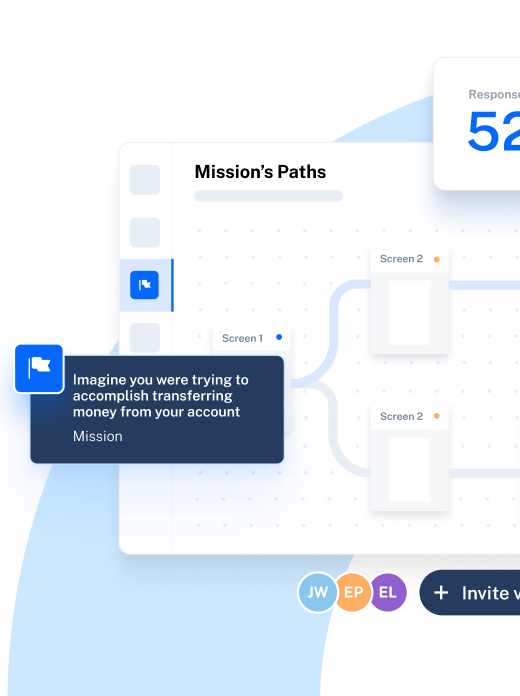Every UX research report was once a mountain of raw, unstructured data. User research repositories help collate that data, disseminate insights, democratize research, and spread the value of user research throughout your organization.
However, building (and maintaining) an accessible user research repository is no simple task. Getting people to use it is a whole other ball game.
In this guide, we’ll break down the specifics of user research repositories, some best practices and the benefits of building your own research library, plus how to get started, and our favorite examples of robust research repositories.
What is a research repository in UX research?
A user research repository is a centralized database which includes all your user research data, UX research reports, and artifacts. Different teams—like design, product, sales, and marketing—can find insights from past projects to contextualize present scenarios and make informed decisions.
Storing all your research data in a single place ensures every team has access to user insights and can use them to make research-driven decisions. Typically maintained by a research operations team, a well-structured research repository is an important step toward breaking down silos and democratizing user research for the entire organization.
If you’re looking to improve research maturity across your organization and start scaling UX research, building a watertight user research repository is your first step.
What’s included in a research repository?
Building a UX research repository can be challenging. Between compiling all the data, creating a collaborative space, and making it easily accessible to the teams who need it, you might be struggling to identify a start point.
Here’s a checklist of all the essentials to streamline the setup:
✅ Mission and vision
✅ Research roadmap
✅ Key methodologies
✅ Tools and templates
✅ Research findings
✅ Raw data and artifacts
Mission and vision
Whether you have a dedicated user research team or involve multiple departments in the UX research process, you need a clear mission and vision statement to create a shared purpose and foster collaboration. Not only should you include your wider UX research strategy and vision, but a ‘North Star’ for your repository, too.
For example, the mission statement for your repository could be, “Streamline our UX design process and promote informed decision-making with a centralized hub of user feedback and insights.”
Research roadmap
A clear UX roadmap makes it easy to prioritize your research efforts and seamlessly organize your repository. It analyzes your objectives and outlines all upcoming projects in a given timeline. You can use this roadmap to catalog your previous research campaigns and plan ahead.
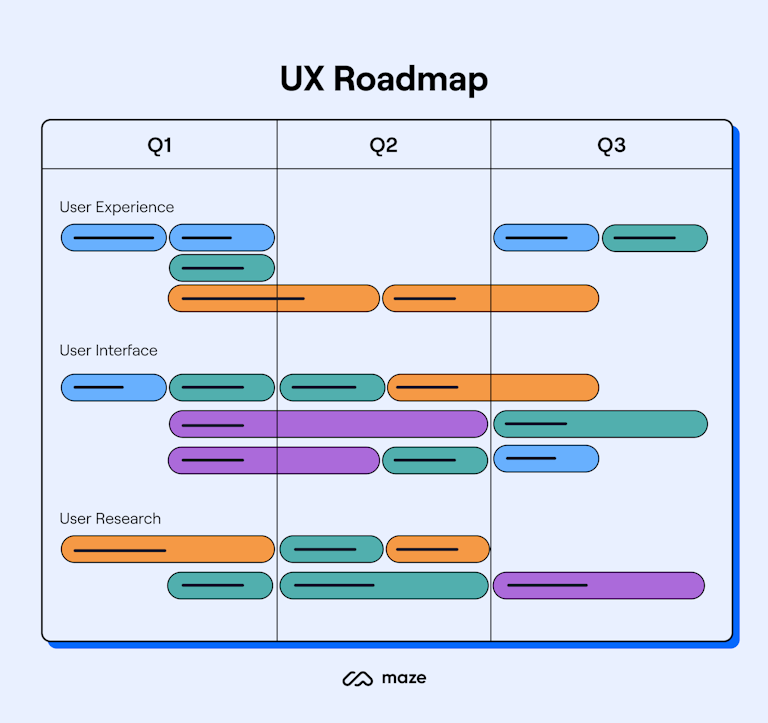
Key methodologies
You should also list all the research methods you follow to create repeatable success. You can save SOPs for different methodologies to minimize the scope of error and set your team members up for success. Mia Mishek, UX Research Operations Program Manager at Pax8, explains:
“Every repository should include common documents related to the research at hand, such as a brief, moderation guide/test script, and readout. Having all the documents easily accessible allows others to cross-reference while consuming research and use past research as a jumping-off point for further research.”
Tools and templates
Create a list of collaboration and product management tools for different steps in the product research process, such as usability testing, interviews, note-taking, data analysis, and more. Outline these and don’t forget to give quick access links to all your UX research tools.
Outlining instructions and key templates for specific research methods or analysis techniques can be useful. Consider including any tried-and-tested question repositories or best practices.
Research findings
Your repository should include a set of findings from every study. While you can add the final reports for all projects, it’s also a good practice to add quick takeaways and tags to make your collection easily searchable.
If you’ve conducted different types of analysis, it’s worth linking these here, too. Whether that’s a photo of your thematic analysis workshop, a walkthrough video of your results, or a link to digital affinity diagram.
Raw data and artifacts
Alongside research reports, you can store all the raw data from each study, like user interview recordings and transcriptions. Your team members can revisit this data to plan upcoming projects effectively or connect the dots between past and present insights.
Depending on how you store this, you may want to consider keeping piles of raw data in a ‘view only’ or locked area of the repository, to avoid risk of accidental tampering or deletion.
What are the benefits of a research repository?
User research is an ongoing process. The trickiest part for most teams when pursuing continuous research is breaking down silos and establishing a democratized approach to prevent wasteful overlap, unnecessary effort, and a lack of knowledge-sharing.
A good research repository fosters a culture of collaboration and supports user-centric design through collectively prioritizing and understanding your users.
Here are a few core benefits of building a user research repository:
Quickly access user research data
An easily searchable UX research repository makes it easy to filter through a mountain of data and find specific insights without pouring hours into it. Mia emphasizes the importance of making the information easily accessible:
“You should be able to go into the repository, understand what research has been done on X topic, and get the information you’re after. If you need someone else to walk you through the repository, or if there’s missing information, then it’s not doing its job.”
By creating a self-serve database, you can make all the data accessible to everyone and save time spent on reviewing prior research to feed existing efforts.
Inspire ideas and prioritize future research
A research repository can also help in identifying knowledge gaps in your existing research and highlight topics worth further exploration. Analyzing your past data can spark ideas for innovative features and guide your research efforts.
Different teams can utilize a research repository to help guide the product roadmap on areas that still need to be explored in the app, or areas that need to be revisited.
Mia Mishek
UX Research Operations Program Leader at Pax8
Share
Build a shared knowledge library
One crucial advantage of a repository is that it helps democratize user research. Not only does it highlight the value of research and showcase the efforts of your product and research teams, but by centralizing research findings, you’re making it easier for everyone to make data-informed, user-centric decisions.
A research repository also provides versatility and other use cases to your research insights—from product managers to sales leaders, all stakeholders can access user insights for making research-driven decisions across the organization. Whether that’s informing a sales pitch, product roadmap, or business strategy; there’s endless applications for UX research.
This practice of knowledge-sharing and democratizing user insights is a big step in building a truly user-centered approach to product development.
Contextualize new data with past evidence
Your repository records all the raw data from past projects, making it easier to compare and contrast new findings with previous user research. This data also allows researchers to develop more nuanced reports by connecting the dots between present and past data.
Mia explains how these repositories cut down on the redundant effort of trying to dig up old research data on any topic: “A repository benefits UX researchers and designers because it’s not uncommon to ask what research was done on XYZ area before conducting more research. No one wants to do reductive work, so without a repository, it’s easy to forget past research on similar topics.”
What’s more, research libraries avoid the same research being repeated; instead allowing as many people as possible to benefit from the research, while minimizing the resources and time used.
4 Best research repository tools and templates
You don’t need a specialized tool to create a user research repository. A well-organized, shared Google Drive or Notion teamspace with detailed documentation can be just as effective. However, if you can, a dedicated tool is going to make your life a lot easier.
Here are four research repository tools to consider for storing existing and new research insights on, and working cross-functionally with multiple teams.
1. Confluence
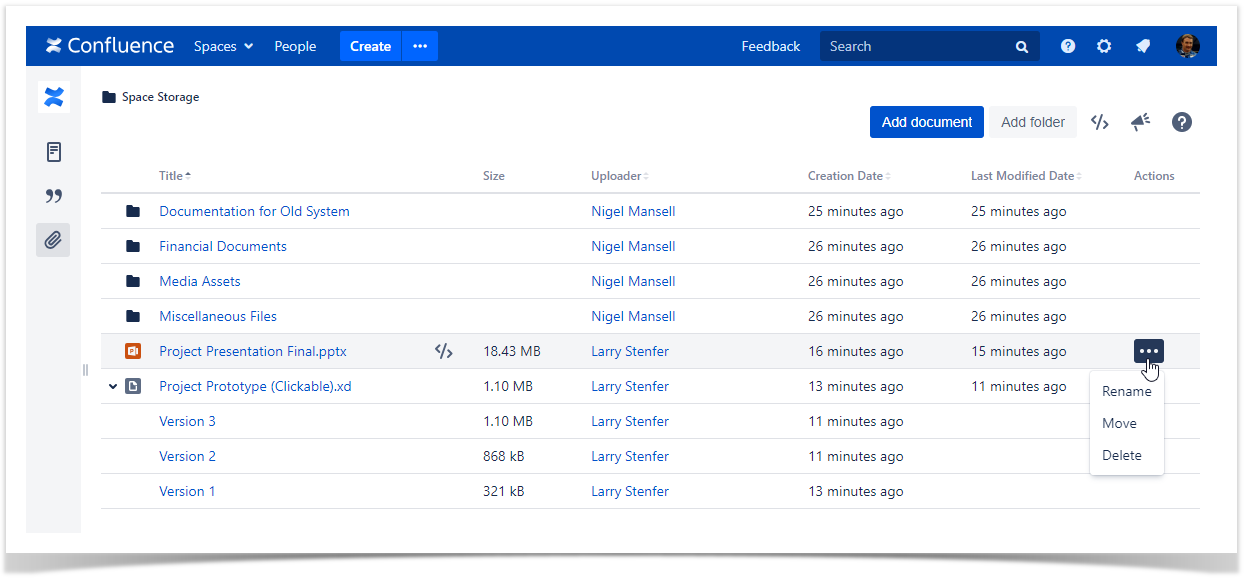
Confluence is a team workspace tool by Atlassian that streamlines remote work. You can use this platform to create research docs from scratch, share them with your team, and save them for future reference. Plus, the tool lets you design wikis for each research study to organize everything—raw data, findings, and reports—in a structured manner.
You also get a centralized space to store data and docs from extra accounts, so multiple people can contribute to and access your repository.
2. Condens
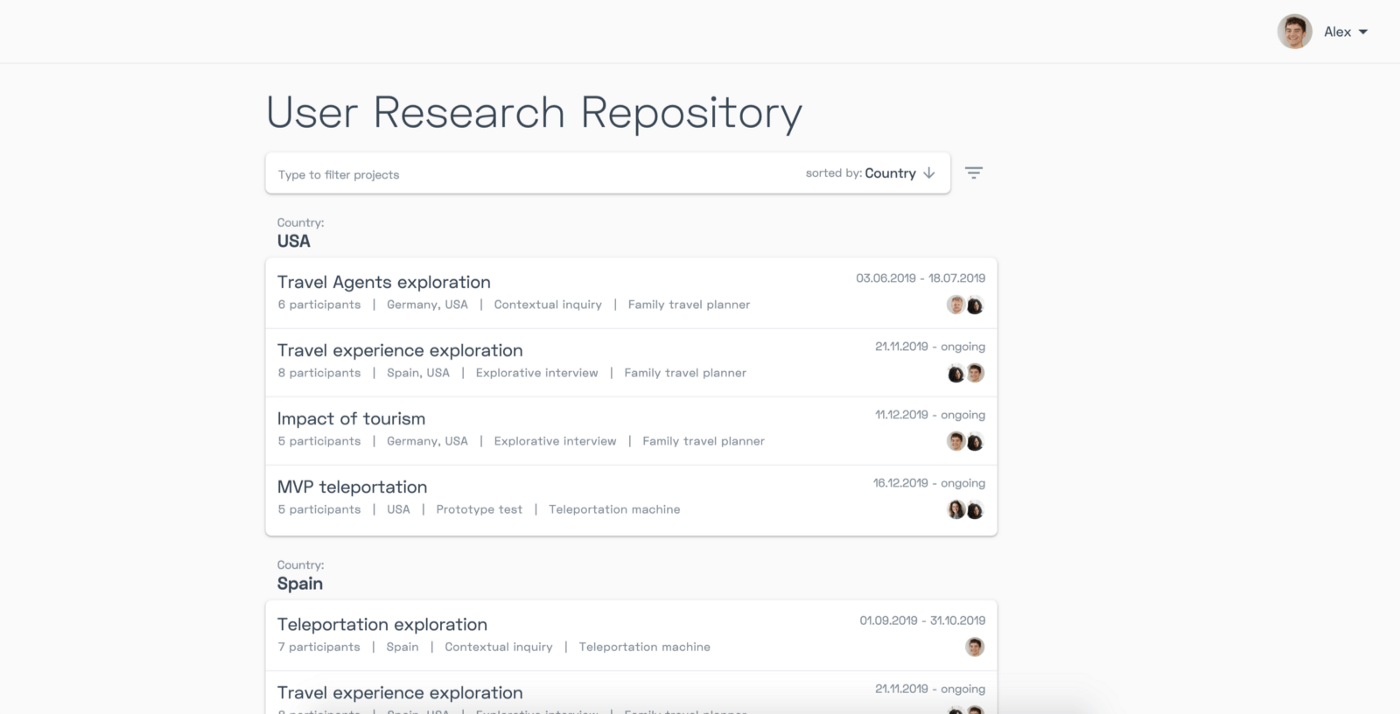
Condens is a centralized UX research and analysis platform for storing, structuring, and analyzing user research data–and sharing those insights across your organization. You can collaborate on data analysis, create pattern recognition, and create artifacts for comprehensive outcomes.
With a detailed research repository guide to help you on your way, it's a great tool for teams of any size. Plus, you can also embed live Maze reports, alongside other UX research and analysis tools.
3. Dovetail
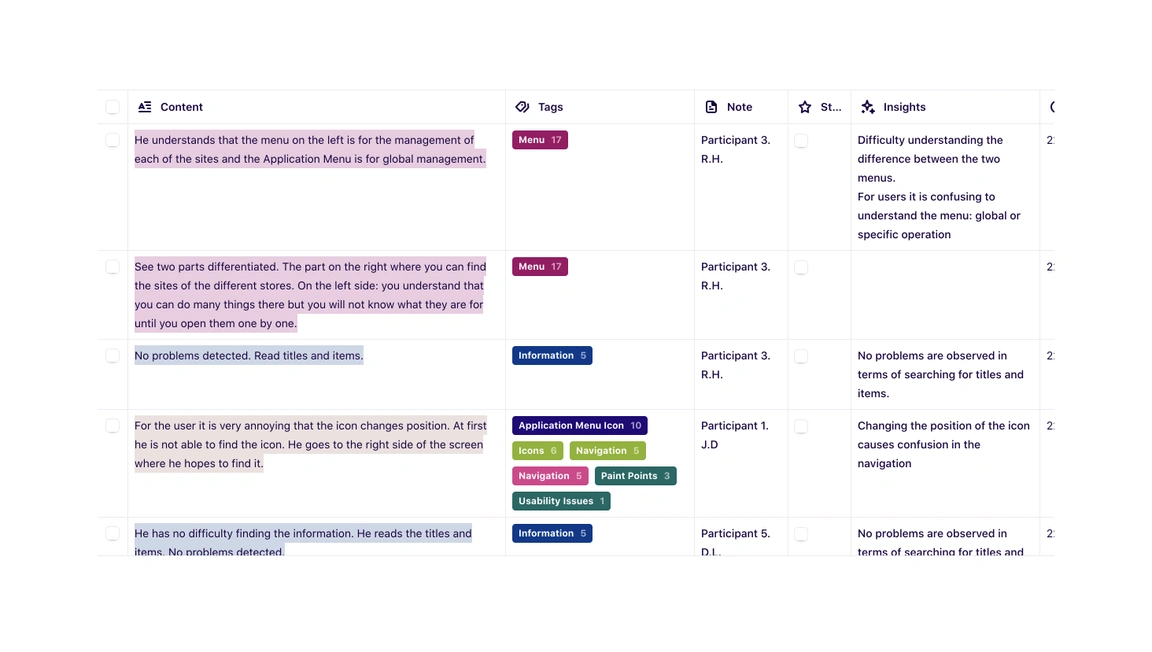
Dovetail is a user research platform for collecting, analyzing, and storing research projects. You can save and retrieve all documents from a single database, while tags, labels, and descriptions also simplify the task of cataloging past data.
The platform gives you a strong search function to quickly find any file or data from the entire hub. You can also use multiple templates to migrate data from different platforms to Dovetail.
4. Airtable
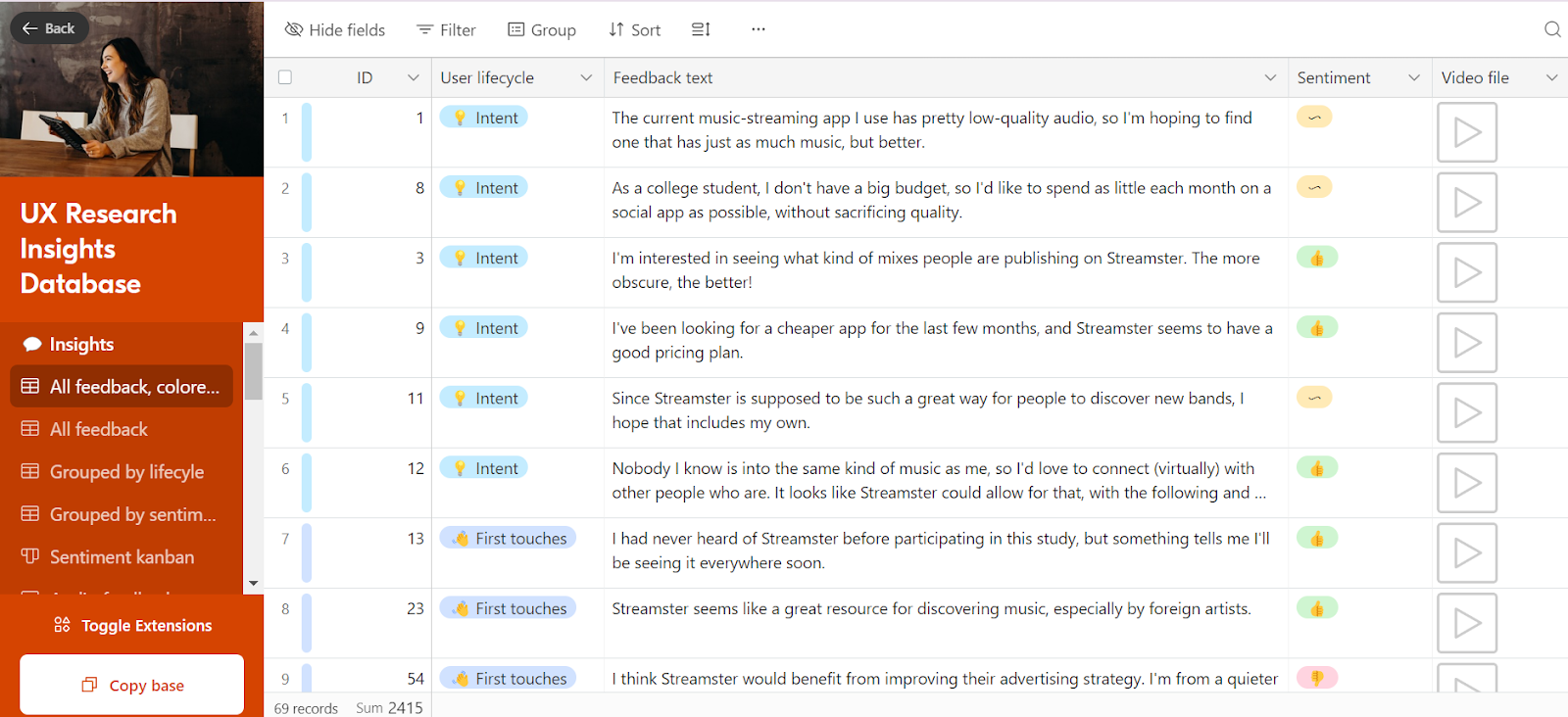
Airtable is a low-code tool for building apps that enables you to create a custom database for your UX research projects. It’s ideal for product teams looking to set up the entire repository from scratch because you need to configure everything independently.
You get a high degree of flexibility to integrate different data sources, design a customized interface, and access data in dynamic views. What’s more, you can build an interactive relational database to request resources from others and stay on top of the status of existing work.
Here’s a research repository database to get started.
Creating a UX research repository: 5 Best practices
Designing a bespoke repository to organize your research requires careful planning, a thorough setup workflow, and continuous maintenance. But once it’s ready, you’ll wonder how your product team survived without it.
To get you started, here’s our five best practices to implement this process effectively and kickstart your repository.
1. Define clear objectives for your repository
Start by outlining what you want to achieve with a shared research library. You might want to standardize research methodologies across the board or build alignment between multiple teams to create more consistent outputs.
This goal-setting exercise gives all team members a purpose to pursue in upcoming projects. When they know what success looks like, they can strategically plan research questions and choose analysis methods.
Knowing your objectives will also help shortlist the best research and usability testing tools. You can invest in a good platform by evaluating a few core capabilities needed to achieve your goals (more on that shortly).
2. Create a structure and define taxonomy
You can structure your UX repository as a database with multiple fields. For example, here are a few fields to easily categorize responses when documenting user experience research:
- Key insights
- User quotes
- Priorities
- Criticality
- Sources of knowledge
- Possible solutions that were considered
Besides creating a structure to document a research study, you also need a well-defined taxonomy to help people find information. Defining your research taxonomy will help you categorize information effectively and design consistent naming conventions.
For example, you can create a set of predefined categories for every research study like:
- Focus country: USA, Australia, Canada, France
- Collected feedback: Feature request, feature enhancement, bugs
- Methodology: Usability testing, user interview, survey
- User journey stage: Before activation, power user, after renewal
💡 Less jargon, more alignment
Involve multiple stakeholders when defining the terminology for your library, and check it aligns with any internal Style Guides or glossaries. This ensures alignment from the outset, and makes it easy for everyone to filter results and find what they need.
3. Distribute knowledge through atomic research
Atomic research is an approach to UX research that prioritizes user research data organization. It proposes that you conduct research so that every piece of the project becomes easily reusable and accessible to all stakeholders.
According to the atomic research approach, you need to consider four components to organize your repository:
- Experiments (We did this): Explain the research methodology and the steps you followed in conducting the study
- Facts (We saw this): Document the main findings evident from the data gathered in the study
- Insights (Which made us think): Capture the key insights extracted from analyzing the research data
- Opportunities (So we did that): List the decisions and action items resulting from the research analysis
Using atomic research, you can create nuggets to organize information in your repository.
Nuggets are the smallest unit of information containing one specific insight, like a user quote, data point, or observation. The different types of nuggets to categorize your research data include observations, evidence, and tags. By breaking down a vast study into smaller nuggets, you can make your repository informative at a glance. You can use your defined taxonomy to label these nuggets.
4. Identify the creators and consumers in your team
Before outlining your repository’s structure, you need to define workflows for creating, reviewing, and maintaining the library. Spend some time defining who will:
- Own the setup process and create the overall guidelines
- Access past documents and add contributions consistently
- Maintain the documents for easy accessibility
- Only need to access customer insights
Assigning these roles makes it easy to estimate your team's bandwidth for building and maintaining such a massive library. You can also manage permissions in your repository platform to give everyone access to relevant materials and protect confidential resources.
Mia explains why this is important to make your repository more meaningful for end-users:
“You need to keep in mind the JTBD (jobs to be done) framework when building a repository. What do the folks accessing your repository need to do? Who are those people? You need to build your repository with the purpose of those distinct users.”
5. Shortlist and finalize tools based on your goals
When evaluating different research repository tools, consider your requirements and compare different platforms against the essential features you need for this repository. If you’re creating one for the first time, it’s okay to create an experimental setup to understand the impact.
Here are a few key factors to consider when shortlisting research repository tools:
- Ease of setup and use: Choose a platform with a gentle learning curve, especially if you have a big team with multiple members. A quick setup and user-friendly interface can maximize adoption and make your repository more accessible.
- Collaboration capabilities: A good repository lets you interact with different team members through comments, chat boxes, or tags. You can also manage permissions and set up different roles to share relevant research with specific stakeholders and team members.
- Tagging and searchability: Your repository is only as good as its ability to show precise search results for any keyword. Consider the ease of labeling new information and test the search function to check the accuracy of the results.
- Export and integrations: You’ll need to export some data or streamline your entire research ops setup by integrating different tools. So, evaluate each tool’s integration capabilities and the options to export information.
Plus, your ideal tool might be a combination of tools. For example, Steven Zhang, former Senior Software Engineer at Airtable, used a combination of Gong and Airtable when first building a UX research repository. It’s about considering your needs and finding what works for your team.
Democratize user research in your organization
A UX research repository gives you easy access to insights from past projects, and enables you to map new insights to old findings for a more nuanced understanding of your users.
More importantly, building a single source of truth for your entire organization means everyone on your team can access research data to inform their projects.
Different teams can use this data to make strategic design decisions, iterate product messaging, or deliver meaningful customer support.
Sound good? That’s what we thought—build your repository today to evangelize and democratize UX research in your organization.
Frequently asked questions about UX research repository
How do I create a user research repository?
How do I create a user research repository?
You can create a user research repository with these best practices:
- Define clear objectives for your repository
- Create a structure and define taxonomy
- Distribute knowledge through atomic research
- Identify the creators and consumers in your team
- Shortlist and finalize tools based on your goals
What makes a good research repository?
What makes a good research repository?
A good research repository tells the team's mission and vision for using research. It's also easily searchable with relevant tags and labels to categorize documents, and includes tools, templates, and other resources for better adoption.
What’s the purpose of a research repository?
What’s the purpose of a research repository?
A research repository aims to make your UX research accessible to everyone. It democratizes research operations and fosters knowledge-sharing, giving everyone on your team access to critical insights and firsthand user feedback.






